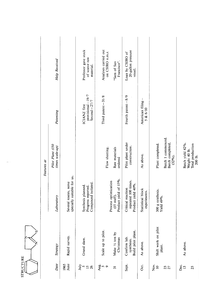


Chapter 9
I Introduction
II The Australian Chemical Industry
III Pharmaceuticals
IV Chemists In Other Industries
V The Dawn Of Modern Chemical Industry - High Pressure Synthesis
VI The Growth Of Synthetic Chemicals - Concentration, Rationalisation And International Links
VII Australian Industrial Chemical Research Laboratories
i Australian instrument inventions
ii Plant protection - overseas and in Australia
iii Successes in the laboratory but . . .
iv Drugs for sheep and cattle revisited Tetramisole - international success and local manufacture
v 'Promicide'* 'Grenade'* to control ticks
vi Technical service R&D
vii Industry/CSIRO/university collaboration
viii Australian entrepreneurs in modern chemistry
VIII The Plastics Industry
IX The Paint Industry
X Acknowledgements
References
Index
Search
Help
Contact us

Drugs for sheep and cattle revisited
Tetramisole - international success and local manufacture
With increasing sophistication in biotechnology the old animal remedies were gradually displaced. Phenothiazine (see p 675) was followed by a new group of anthelmintics (worm controlling drugs), the benzimidazoles, particularly thiabendazole, a complex heterocyclic compound invented and developed by Merck, Sharpe and Dohme in the U.S.A. It was far more potent and effective against a wider spectrum. Within two years of appearance it dominated the market. At about that time a Belgian inventor discovered another anthelmintic drug, as yet not fully developed, tetramisole. It was again a complex heterocyclic compound, effective in minute doses (fifty times more potent than phenothiazine), water soluble and acting systemically, so that it could be administered by injection as well as by the conventional route, orally. The chances were that it would become one of the world's major veterinary drugs. The Belgian entrepreneur, lacking resources for worldwide development, offered the drug to four of the largest drug companies in the world for further development. The catch was that at the time the only known process involved some seven or eight steps and was unlikely to be industrially viable. In Australia anthelmintics were the largest veterinary drug market, but by then ICI Australia had but a small share of it. There clearly was an incentive to find a route. All the major drug companies licensed worked on this feverishly. The organic chemists at ICI Australia's Research Lab were keen to enter the competition. To create the financial incentive ICI UK and ICI Australia agreed on the usual exchange of information, but manufacture was to be subject to commercial negotiation of appropriate royalties, depending on the circumstances. Events evolved remarkably quickly; the Australians (A. Baklien, J. E. Kolm)[102] using an intermediate which had only just come onto the international market, invented a new reaction (thiazolidines from aziridines) resulting in a dramatic simplification of the synthesis. One great attraction of the compound and synthesis was that such minute doses were active that a few tonnes would suffice for market development and even production for major markets was well within the scope of local manufacture. In competition with four overseas synthesis teams, speed was critical and project teams were established on laboratory synthesis, pilot plant work and patenting. The path from conception to first pilot plant batch -enough for substantial field trials in just six months -has been described by the R&D Director at the time, Dr. W. L. Weickhardt[103] from which the schedule on p 688 is taken, and Baklien et al.[104]

(See Baklien, Leeding and Kolm, Australian Journal of Chemistry, 1968, 21, 1557-70.)
The concentrated effort was not misplaced; within two months another licensee virtually re-discovered an almost identical route, even though the aziridine/thiazolidine ringclosure was new chemistry. Again the UK research team, in friendly, co-ordinated competition, was generous and supportive. They took on the process as the 'corporate' route and did all the toxicology without which progress would have been inconceivable and assisted in international negotiations with licensees keen to use the new route. ICI Australia's chances to manufacture the product were excellent; the prospects of licensing were good because the process was simple and cost effective. Yet with process patents evasions are always possible. Hence the team looked at possibilities to consolidate its position.
Organisations in Australian Science at Work - I.C.I. Australia Ltd. Central Research Laboratories; Merck, Sharp and Dohme (Australia) Pty Ltd
People in Bright Sparcs - Baklien, A.; Kolm, J. E.; Weickhardt, L. W.
 |
Australian Academy of Technological Sciences and Engineering |  |
© 1988 Print Edition page 687, Online Edition 2000
Published by Australian Science and Technology Heritage Centre, using the Web Academic Resource Publisher
http://www.austehc.unimelb.edu.au/tia/654.html